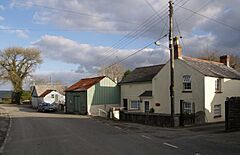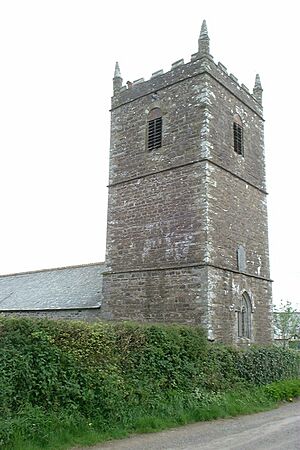Boyton, Cornwall facts for kids
Quick facts for kids Boyton
|
|
|---|---|
 Boyton |
|
| Lua error in Module:Location_map at line 530: Unable to find the specified location map definition: "Module:Location map/data/Cornwall (mainland)" does not exist. | |
| Population | 457 (United Kingdom Census 2011) |
| OS grid reference | SX319919 |
| Civil parish |
|
| Unitary authority | |
| Ceremonial county | |
| Region | |
| Country | England |
| Sovereign state | United Kingdom |
| Post town | LAUNCESTON |
| Postcode district | PL15 |
| Dialling code | 01566 |
| Police | Devon and Cornwall |
| Fire | Cornwall |
| Ambulance | South Western |
| EU Parliament | South West England |
| UK Parliament |
|
Boyton (called Cornish: Trevoya in Cornish) is a small village and civil parish in Cornwall, England. A civil parish is like a local area with its own council. Boyton is located near the River Tamar, which forms the border with Devon. It's about 10 kilometers (6 miles) north of Launceston. In 2011, about 457 people lived here.
Boyton is a countryside area. Its name comes from "Boia's Farm." The village was mentioned in the Domesday Book as Boitone. The Domesday Book was a huge survey of England made in 1086. It helped King William the Conqueror understand who owned what land.
Boyton is bordered by Devon to the east. To the north, it's next to North Tamerton parish. North Petherwin parish is to the west. To the south, it borders Werrington parish. Boyton is part of the Launceston Registration District.
The area of Boyton was recorded in the Domesday Book in 1086. It was one of several areas owned by Hamelin. He held them from Robert, Count of Mortain. The record shows there was enough land for four ploughs. There were also three servants, two villagers, and three small farmers. The area had some woodland and pasture for animals. It was home to 6 cattle and 30 sheep.
Boyton Mill
At Boyton Mill, the miller's house is built from stone and wooden beams. The mill building itself has many original parts. The waterwheel and its machinery still turn. You can even see them working today. Some parts of the mill building are very old, dating back to the 1200s. The main house is over 500 years old.
The small communities of Bennacott, Curry Lane, North Beer, and West Curry are all part of Boyton parish.
The Church of the Holy Name
Boyton parish church is called the Church of the Holy Name. It was built on the site of an even older church. That first church was built in the Norman style. The current church was dedicated in the 1300s.
The church has a main area called a nave. It also has a chancel, which is where the altar is. There's a south aisle, which is a side section. The church also has a tower. The tower was built in the 1300s. The south aisle was added in the 1400s. Part of the tower was rebuilt between 1692 and 1694.
You can still see parts of the old rood screen. This was a screen that separated the chancel from the nave. The church also has old wagon roofs. The roof in the aisle is a great example of this style. The font is where baptisms happen. It is plain and very old, from the early Norman period. It has an unusual oval shape.
Notable People
Tim Smith
Tim Smith was born in 1947. He is a politician. A politician is someone who works in government. They represent people in their area. Tim Smith was a Member of Parliament (MP). An MP is elected to speak for their local area in the UK Parliament. He was an MP for Ashfield from 1977 to 1982. Then he was an MP for Beaconsfield from 1982 to 1997. He lives in Boyton.


